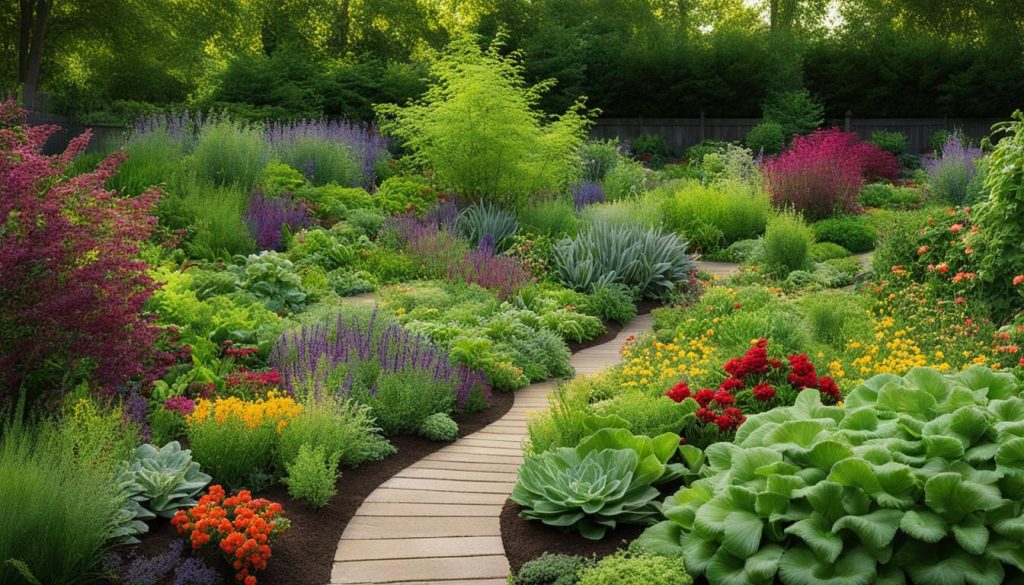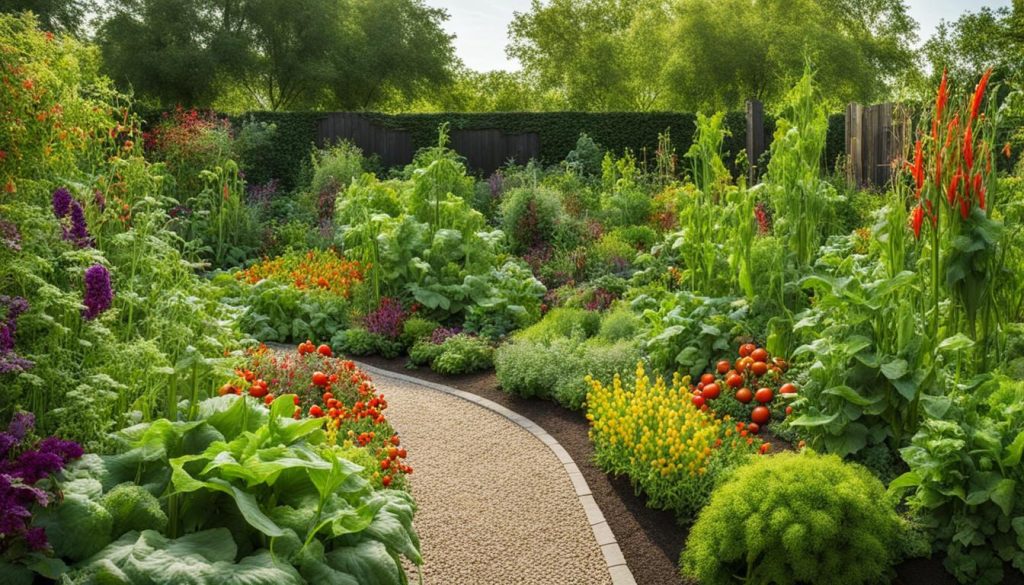Welcome to our guide on landscaping with edible plants! If you’re looking to enhance the aesthetics of your outdoor space while also reaping the benefits of fresh produce, then you’ve come to the right place. Edible plants offer a unique and practical way to design your garden, combining beauty and functionality in one.
With the rise of sustainable living and eco-friendliness, more and more people are turning to edible plants for landscaping. Why have a traditional garden when you can have one that’s not only beautiful but also practical? In this section, we’ll explore the possibilities of using edible plants in your garden and how you can create a space that’s both functional and visually pleasing.
Key Takeaways:
- Edible plants offer a unique way to design your garden and enhance the aesthetics of your outdoor space.
- Landscaping with edible plants is a sustainable and eco-friendly option.
- Designing a garden with edible plants allows you to enjoy fresh produce straight from your backyard.
- There are endless possibilities when it comes to using edible plants in your garden design, from vegetables to fruits and herbs.
- Combining beauty and functionality is the key to a successful garden with edible plants.
Sustainable Landscaping with Edible Plants: Enhancing Food Production
When it comes to landscaping with edible plants, sustainability is key. Not only does it reduce the amount of resources needed to produce and transport food, but it also promotes a healthier environment. By incorporating edible plants into your landscape design, you can create a more sustainable and food-producing garden. Here are some tips to get you started:
Start with a Plan
Before you start planting, it’s essential to have a plan in place. Decide which plants you want to grow and where they will be located. Consider factors such as sunlight, soil quality, and water availability. By doing so, you can ensure that your garden will thrive while minimizing the resources required to maintain it.

Choose the Right Plants
When selecting plants for your edible landscape, consider choosing ones that are naturally resilient and require minimal maintenance. For example, herbs and leafy greens like kale and Swiss chard are easy to grow and resilient to harsh conditions. Additionally, consider perennial plants such as fruit trees and berry bushes. These plants require less maintenance and produce food year after year.
Maximize Your Space
Whether you have a small balcony or a large yard, you can maximize your space by incorporating edible plants into your landscape design. Consider using vertical gardening techniques such as trellises or hanging baskets to save space. Additionally, think creatively about how you can incorporate edible plants into your existing landscape. For example, replace traditional ornamental bushes with blueberry bushes or rosemary shrubs.
Reduce Waste
Finally, one of the most significant benefits of sustainable landscaping with edible plants is the reduction of waste. By growing your food, you can reduce the amount of food waste produced by grocery stores and restaurants. Additionally, you can compost any leftover plant materials to create nutrient-rich soil for your garden.
In conclusion, sustainable landscaping with edible plants provides an excellent opportunity to reduce waste, save resources, and promote a healthier environment. By following these tips and incorporating edible plants into your landscape design, you can create a beautiful and functional garden that enhances food production while minimizing environmental impact.
Designing an Edible Front Yard: Combining Beauty and Functionality.
Are you looking to take your front yard to the next level? Creating an edible front yard is an excellent way to combine beauty and functionality. Growing edible plants in your backyard is a great start, but designing an edible front yard takes your gardening game to another level. In this section, we will explore the basics of edible front yard landscaping to help you achieve the perfect balance of beauty and productivity.
Plant Selection
The first step in creating an edible front yard is plant selection. Choose plants that are both edible and beautiful. Examples of edible plants that add aesthetics to your front yard include blueberry bushes, Swiss chard, and artichokes. When selecting plants, consider the climate, soil, sun exposure, and water requirements. Research what plants thrive in your area and choose varieties that are suitable for your environment.
Layout Design
When designing the layout of your edible front yard, consider the aesthetic appeal of the plants and their productivity. Group plants together based on their watering needs and choose a layout that complements the existing structure of your home. Consider using raised beds or containers if you’re working with limited space.
Maintenance
Edible front yard landscaping requires more maintenance than traditional front yard landscaping. Regular watering, fertilization, and pruning are essential to the success of your edible garden. Keep in mind that some edible plants, such as herbs, may attract bees and other insects, so consider this when selecting plants and deciding where to plant them.
Creating an edible front yard is an excellent way to showcase your gardening skills while also providing fresh, homegrown produce. By following the tips outlined above, you can design a stunning front yard that is both practical and visually appealing. Happy gardening!
At Landscaping Markham, we’re committed to delivering quality work and exceptional customer service on every project, consistently.
FAQ
What are the benefits of landscaping with edible plants?
Landscaping with edible plants offers numerous benefits. It allows you to create a beautiful garden that produces fresh and delicious produce, providing you with a sustainable source of food. Additionally, edible plants can enhance the overall aesthetics of your outdoor space, adding color, texture, and visual interest.
How can I design a sustainable landscape with edible plants?
Designing a sustainable landscape with edible plants involves considering factors such as soil health, water conservation, and biodiversity. You can maximize food production by using organic gardening practices, incorporating companion planting techniques, and utilizing efficient irrigation systems. It’s also important to choose plant varieties that are well-suited to your local climate and soil conditions.
Can I create an edible front yard that is both beautiful and functional?
Absolutely! Designing an edible front yard allows you to combine beauty and functionality. You can select a variety of edible plants that offer both visual appeal and delicious harvests. By carefully planning the layout and incorporating design elements such as pathways, raised beds, and decorative containers, you can create an inviting space that showcases the beauty of edible plants while maintaining practicality.

